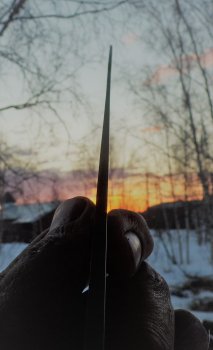My plunges were uneven and I got too thin while working on blending the plunges out. I'd like to save the knife even if it ends up thin - but I don't think I have many chances left so I thought I should seek advice.
I was thinking to one, either grind for a tapered tang which I started half heartedly, Or two, should I try for a full distal from butt to tip. This would shorten the entire knife.
Knife is flat ground about 1.5" at it's widest with 6" cutting edge. The thickest part is the handle at the bottom of the first pic (3/16"). Skinniest part is right in front of the finger guard and forward about 2". The spine there is between 1/8" - 3/32"
thanks, luke
I was thinking to one, either grind for a tapered tang which I started half heartedly, Or two, should I try for a full distal from butt to tip. This would shorten the entire knife.
Knife is flat ground about 1.5" at it's widest with 6" cutting edge. The thickest part is the handle at the bottom of the first pic (3/16"). Skinniest part is right in front of the finger guard and forward about 2". The spine there is between 1/8" - 3/32"
thanks, luke





